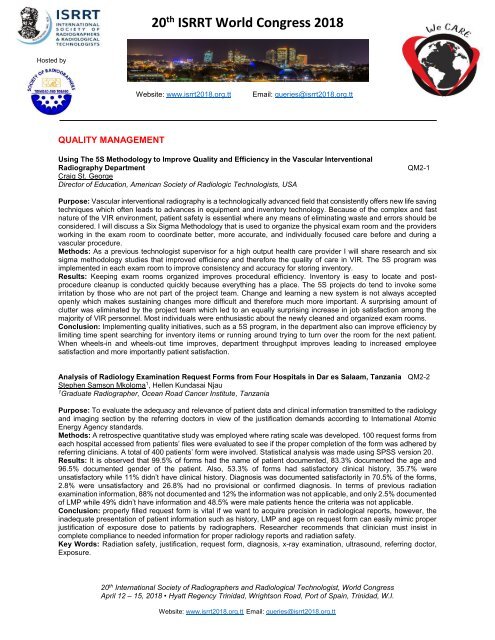Trinidad-and-Tabago-Congerss-Abstract-Book
Create successful ePaper yourself
Turn your PDF publications into a flip-book with our unique Google optimized e-Paper software.
20 th ISRRT World Congress 2018<br />
Hosted by<br />
Website: www.isrrt2018.org.tt<br />
Email: queries@isrrt2018.org.tt<br />
QUALITY MANAGEMENT<br />
Using The 5S Methodology to Improve Quality <strong>and</strong> Efficiency in the Vascular Interventional<br />
Radiography Department<br />
Craig St. George<br />
Director of Education, American Society of Radiologic Technologists, USA<br />
QM2-1<br />
Purpose: Vascular interventional radiography is a technologically advanced field that consistently offers new life saving<br />
techniques which often leads to advances in equipment <strong>and</strong> inventory technology. Because of the complex <strong>and</strong> fast<br />
nature of the VIR environment, patient safety is essential where any means of eliminating waste <strong>and</strong> errors should be<br />
considered. I will discuss a Six Sigma Methodology that is used to organize the physical exam room <strong>and</strong> the providers<br />
working in the exam room to coordinate better, more accurate, <strong>and</strong> individually focused care before <strong>and</strong> during a<br />
vascular procedure.<br />
Methods: As a previous technologist supervisor for a high output health care provider I will share research <strong>and</strong> six<br />
sigma methodology studies that improved efficiency <strong>and</strong> therefore the quality of care in VIR. The 5S program was<br />
implemented in each exam room to improve consistency <strong>and</strong> accuracy for storing inventory.<br />
Results: Keeping exam rooms organized improves procedural efficiency. Inventory is easy to locate <strong>and</strong> postprocedure<br />
cleanup is conducted quickly because everything has a place. The 5S projects do tend to invoke some<br />
irritation by those who are not part of the project team. Change <strong>and</strong> learning a new system is not always accepted<br />
openly which makes sustaining changes more difficult <strong>and</strong> therefore much more important. A surprising amount of<br />
clutter was eliminated by the project team which led to an equally surprising increase in job satisfaction among the<br />
majority of VIR personnel. Most individuals were enthusiastic about the newly cleaned <strong>and</strong> organized exam rooms.<br />
Conclusion: Implementing quality initiatives, such as a 5S program, in the department also can improve efficiency by<br />
limiting time spent searching for inventory items or running around trying to turn over the room for the next patient.<br />
When wheels-in <strong>and</strong> wheels-out time improves, department throughput improves leading to increased employee<br />
satisfaction <strong>and</strong> more importantly patient satisfaction.<br />
Analysis of Radiology Examination Request Forms from Four Hospitals in Dar es Salaam, Tanzania QM2-2<br />
Stephen Samson Mkoloma 1 , Hellen Kundasai Njau<br />
1 Graduate Radiographer, Ocean Road Cancer Institute, Tanzania<br />
Purpose: To evaluate the adequacy <strong>and</strong> relevance of patient data <strong>and</strong> clinical information transmitted to the radiology<br />
<strong>and</strong> imaging section by the referring doctors in view of the justification dem<strong>and</strong>s according to International Atomic<br />
Energy Agency st<strong>and</strong>ards.<br />
Methods: A retrospective quantitative study was employed where rating scale was developed. 100 request forms from<br />
each hospital accessed from patients’ files were evaluated to see if the proper completion of the form was adhered by<br />
referring clinicians. A total of 400 patients’ form were involved. Statistical analysis was made using SPSS version 20.<br />
Results: It is observed that 99.5% of forms had the name of patient documented, 83.3% documented the age <strong>and</strong><br />
96.5% documented gender of the patient. Also, 53.3% of forms had satisfactory clinical history, 35.7% were<br />
unsatisfactory while 11% didn’t have clinical history. Diagnosis was documented satisfactorily in 70.5% of the forms,<br />
2.8% were unsatisfactory <strong>and</strong> 26.8% had no provisional or confirmed diagnosis. In terms of previous radiation<br />
examination information, 88% not documented <strong>and</strong> 12% the information was not applicable, <strong>and</strong> only 2.5% documented<br />
of LMP while 49% didn’t have information <strong>and</strong> 48.5% were male patients hence the criteria was not applicable.<br />
Conclusion: properly filled request form is vital if we want to acquire precision in radiological reports, however, the<br />
inadequate presentation of patient information such as history, LMP <strong>and</strong> age on request form can easily mimic proper<br />
justification of exposure dose to patients by radiographers. Researcher recommends that clinician must insist in<br />
complete compliance to needed information for proper radiology reports <strong>and</strong> radiation safety.<br />
Key Words: Radiation safety, justification, request form, diagnosis, x-ray examination, ultrasound, referring doctor,<br />
Exposure.<br />
20 th International Society of Radiographers <strong>and</strong> Radiological Technologist, World Congress<br />
April 12 – 15, 2018 • Hyatt Regency <strong>Trinidad</strong>, Wrightson Road, Port of Spain, <strong>Trinidad</strong>, W.I.<br />
Website: www.isrrt2018.org.tt Email: queries@isrrt2018.org.tt


















